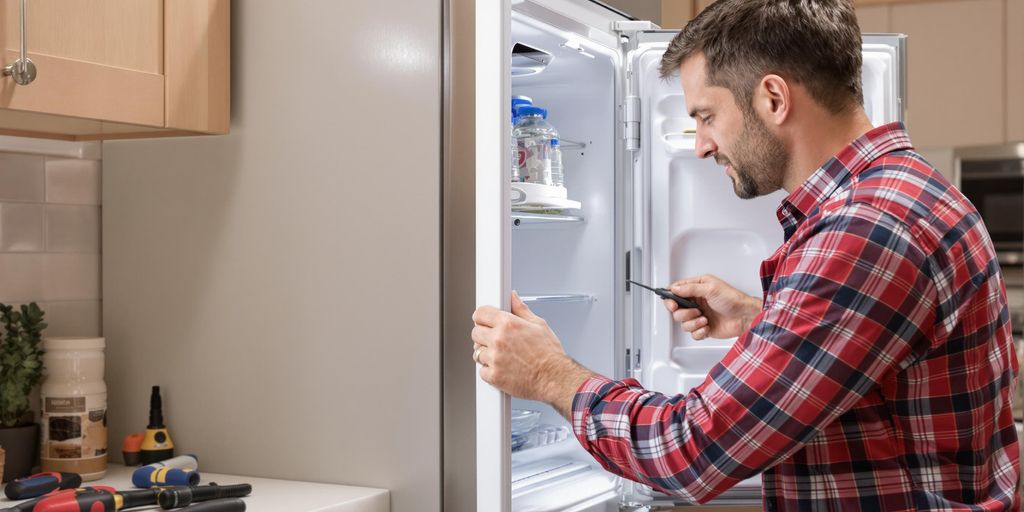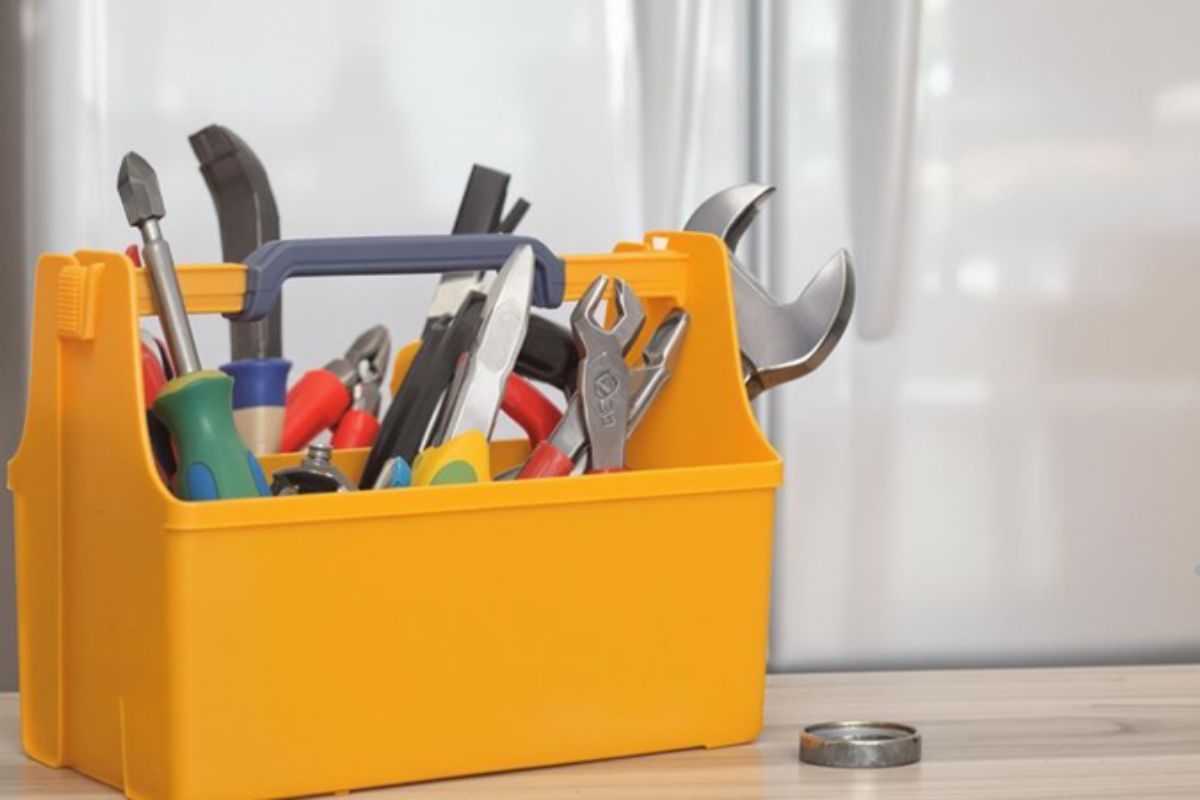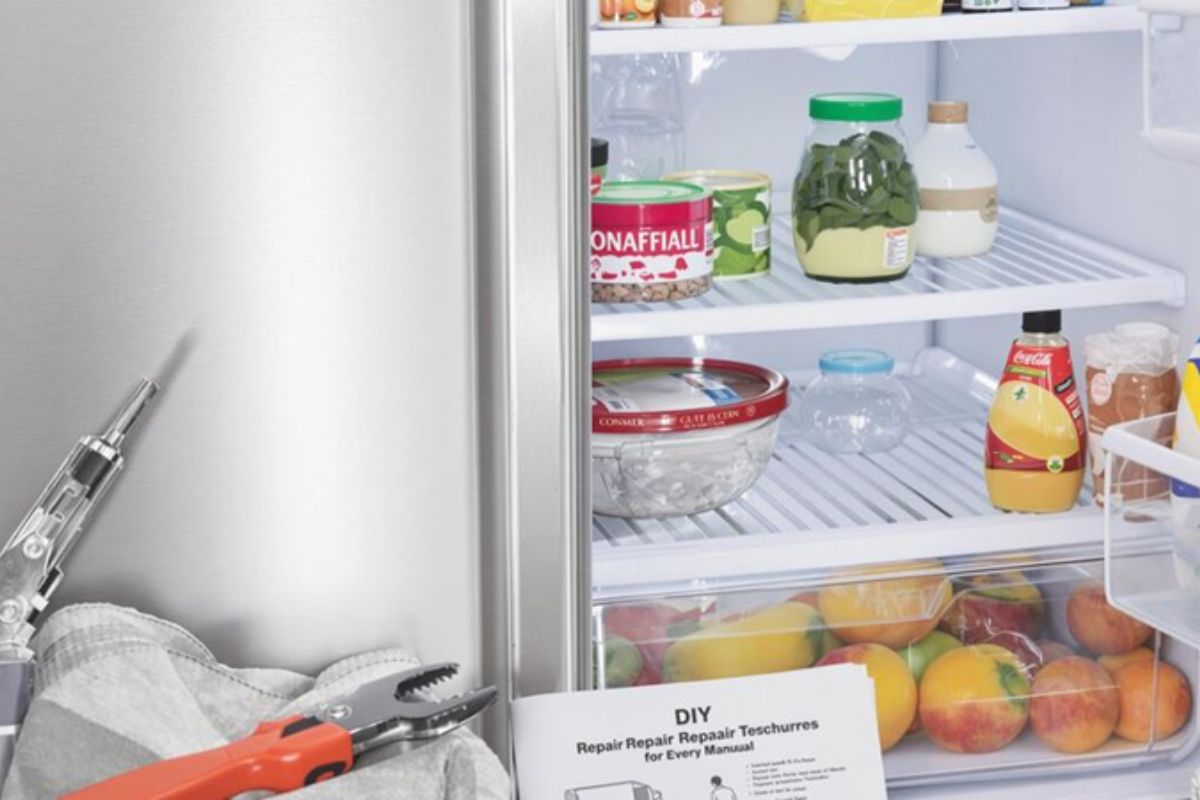
Refrigerators are one of those appliances we don’t think about much—until they stop working. Whether it’s a puddle of water on the floor or food that’s not staying cold, dealing with fridge problems can be frustrating. The good news? With a little know-how and the right tools, you can handle a lot of these issues yourself. This guide will walk you through practical refrigerator repair tips to help you save time and money.
Key Takeaways
- Learn to spot common refrigerator issues like leaks, odd noises, and temperature changes early.
- Keep basic tools and safety gear handy for quick DIY refrigerator fixes.
- Regular maintenance, like cleaning coils and checking door seals, can extend your fridge’s life.
- Understand when it’s time to call a professional to avoid making things worse.
- Simple changes, like organizing food better and using energy-efficient parts, can save on energy bills.
Common Refrigerator Problems and How to Identify Them
Recognizing Temperature Fluctuations
One of the first signs your refrigerator might be acting up is inconsistent cooling. Food spoiling faster than usual or frozen items thawing in the freezer are big red flags. Use a thermometer to check if the internal temperature is staying within the recommended range: 35°F to 38°F for the fridge and 0°F for the freezer. If it’s off, it could be a sign of a faulty thermostat, blocked vents, or dirty condenser coils.
Identifying Unusual Noises
Refrigerators aren’t silent, but they also shouldn’t sound like a construction zone. Pay attention to:
- Buzzing: Could mean the compressor is overworking.
- Clicking: Might indicate an issue with the start relay.
- Humming or rattling: Often points to loose parts or a fan problem.
If the noise is persistent or gets louder, it’s time to investigate further.
Spotting Leaks and Water Build-Up
Puddles of water near your fridge aren’t just annoying—they’re a sign something’s wrong. Check for:
- A clogged or frozen defrost drain.
- Cracks in the water supply line (if your fridge has an ice maker).
- Condensation due to improper sealing of the door gasket.
Addressing these issues quickly can prevent further damage to your appliance and your floor.
Regularly inspecting your fridge for these problems can save you time, frustration, and money in the long run.
Keeping your appliances in top shape is essential for their longevity and efficiency. Explore our services for expert refrigerator maintenance and repair solutions. From routine check-ups to complete fixes, we’ve got you covered!
Essential Tools for Basic Refrigerator Repairs

Must-Have Tools for DIY Repairs
Tackling refrigerator repairs on your own? You’ll need a few reliable tools to make the job easier. A good set of tools can save you time and frustration. Here’s what you should have on hand:
- Screwdrivers: Both flathead and Phillips are necessary for removing panels and screws.
- A multimeter: This is essential for testing electrical components, ensuring they’re functioning properly. Learn more about multimeters.
- Wrenches: Adjustable wrenches help with bolts and nuts, especially in tight spaces.
- Pliers: Needle-nose pliers are particularly handy for gripping small parts.
- A flashlight: A bright, focused light will help you see inside dark, cramped areas.
Safety Gear to Keep on Hand
Safety is key when working with appliances. Always have these items ready before you start:
- Insulated gloves: These protect against electrical shocks.
- Safety goggles: Prevent debris or liquids from getting into your eyes.
- A dust mask: Useful when cleaning coils or dealing with old, dusty components.
Before starting any repair, unplug your refrigerator. This simple step can prevent accidents and injuries.
Where to Purchase Reliable Repair Tools
Finding quality tools doesn’t have to be a headache. Here are a few tips:
- Local hardware stores: They often have knowledgeable staff who can guide you.
- Online retailers: Look for customer reviews to find durable, well-rated tools.
- Specialty appliance repair shops: These places sometimes carry tools designed specifically for refrigerators.
Investing in good tools not only makes repairs easier but also ensures they’re done right the first time.
How to Maintain Your Refrigerator for Longevity
Cleaning the Coils Effectively
The coils at the back or bottom of your fridge are like its lungs—they help it breathe and stay cool. Over time, these coils collect dust, pet hair, and all sorts of grime. Keeping them clean helps your fridge run more efficiently and prevents it from overworking. Here’s how you can clean them:
- Unplug the fridge for safety.
- Use a coil brush or a vacuum with a brush attachment to gently remove dirt.
- Wipe the area around the coils to keep it dust-free.
Do this at least twice a year, or more often if you have pets that shed.
Keep your refrigerator running efficiently for years with proper maintenance! Need professional help? Call us now at for expert refrigerator servicing and ensure your appliance stays in top condition.
Ensuring Proper Door Seals
A loose or cracked door seal can cause cold air to escape, forcing your fridge to work harder. To check if your seals are in good shape, close the door on a piece of paper. If it slides out easily, you might need to replace the seals. A tight seal keeps your food fresh and your energy bills lower.
Steps to maintain the seals:
- Clean them with warm, soapy water to remove grime.
- Inspect for cracks or wear regularly.
- Replace them if they’re no longer flexible or sealing properly.
Setting the Right Temperature
Your fridge’s temperature setting is more important than you might think. Too cold, and you’re wasting energy. Too warm, and your food might spoil. Aim for a fridge temperature of around 37°F (3°C) and a freezer setting of 0°F (-18°C). Adjust the settings if you notice food freezing in the fridge or thawing in the freezer.
A well-maintained fridge not only saves you money but also keeps your food safer for longer. Minimizing door openings and maintaining airflow around the appliance can also help extend its life.
Refrigerators are often taken for granted—until they break down. From unexpected leaks to food not staying cold, fridge issues can be frustrating. The good news? With the right knowledge and tools, you can fix many problems yourself. This guide offers practical repair tips to save you time and money.
If you’re dealing with a Samsung fridge freezing your food, check out our detailed troubleshooting guide troubleshooting guide here for solutions!
Troubleshooting Electrical Issues in Your Refrigerator
Checking the Power Supply
First things first: is your fridge even getting power? This might sound obvious, but sometimes the issue is as simple as a tripped circuit breaker or a loose plug. Start by:
- Making sure the refrigerator is securely plugged in.
- Checking if other appliances in the same outlet are working.
- Inspecting your home’s electrical panel for any flipped breakers.
If everything checks out but the fridge still won’t turn on, it’s time to dig a little deeper.
Inspecting the Circuit Board
The circuit board is like the brain of your fridge. If it’s fried or malfunctioning, things can go haywire. Look for signs like burnt marks or a strange smell near the back of your fridge. To inspect it:
- Unplug your refrigerator for safety.
- Locate the control board (usually behind a panel at the back).
- Look for visible damage—burnt spots, melted plastic, or loose connections.
If you spot any of these, you may need to replace the board. Be cautious, though—this can be tricky, and you might want to call in a pro if you’re unsure.
Replacing Faulty Wiring
Damaged wiring can cause all sorts of problems, like intermittent power or complete shutdowns. If you suspect faulty wiring:
- Inspect the power cord for any visible damage, like fraying or cuts.
- Check inside the fridge for loose or disconnected wires.
- Use a multimeter to test for continuity if you’re comfortable with electrical tools.
Replacing wires isn’t overly complicated, but it does require patience and attention to detail. Always use the same type of wire to avoid compatibility issues.
Electrical problems can be frustrating, but with a little patience and the right approach, they’re often fixable without needing to spend a fortune.
When to Call a Professional for Refrigerator Repairs

Signs You Need Expert Help
Sometimes, no matter how handy you are, a refrigerator issue might be beyond your skill set. If your fridge completely stops cooling, that’s a red flag that you need professional help. Another sign? Frequent cycling—if your fridge keeps turning on and off, it could point to a compressor or thermostat problem. Additionally, if you notice a persistent burning smell or see sparks, unplug the appliance immediately and call an expert.
Here are a few more signs to watch for:
- Unusual noises that persist after basic troubleshooting.
- A freezer that won’t freeze, even after adjusting the settings.
- Visible damage to electrical components or wiring.
Understanding Repair Costs
Before calling in a technician, it’s good to have an idea of what you might be spending. Here’s a quick breakdown of common refrigerator repair costs:
| Repair Type | Estimated Cost Range |
| Compressor Replacement | $200 – $650 |
| Thermostat Repair | $100 – $300 |
| Circuit Board Replacement | $150 – $400 |
| Door Seal Replacement | $50 – $200 |
Keep in mind, costs can vary depending on the brand, model, and location. Always ask for an estimate upfront to avoid surprises.
Finding a Trusted Technician
Finding a reliable repair service doesn’t have to be stressful. Start by asking friends or family for recommendations—they’ve probably had a similar issue at some point. You can also check reviews online, but take them with a grain of salt. Look for technicians who specialize in your refrigerator’s brand or model.
When reaching out, ask these questions:
- Are they licensed and insured?
- Do they provide a warranty for their work?
- Can they give you a detailed quote before starting?
Trust your gut. If a technician seems evasive or unprofessional, it’s okay to look elsewhere. A good repair expert will be transparent and willing to answer your questions.
“Protect your lawn from damage and keep it looking flawless with our expert lawn care services! Whether it’s artificial or natural turf, we’ve got you covered. Call us today at for professional care and maintenance!
Energy Efficiency Tips for Your Refrigerator
Organizing Food for Better Airflow
Keeping your fridge organized isn’t just about finding things quickly—it actually helps with energy efficiency. When air can flow freely between items, the cooling system doesn’t have to work as hard. Here are some tips to make it happen:
- Leave some space between items so air can circulate.
- Avoid overloading shelves; a packed fridge blocks airflow.
- Group similar items together to make retrieval faster and reduce the time the door stays open.
Upgrading to Energy-Saving Components
If your fridge is older, it might be worth looking into energy-saving upgrades. Switching to LED lighting inside the fridge, for example, can cut down on energy use compared to traditional bulbs. You might also consider replacing old gaskets or seals that don’t close tightly anymore. For those who are more tech-savvy, installing a smart thermostat or energy monitor could be a game-changer.
| Component | Energy-Saving Benefit |
| LED Lighting | Uses less power than traditional bulbs |
| New Door Gaskets | Prevents cold air from escaping |
| Smart Thermostat | Optimizes cooling cycles |
Reducing Energy Consumption
Sometimes, the simplest changes make the biggest difference. Here’s what you can do to cut down on energy use:
- Set the fridge temperature to around 37°F and the freezer to 0°F. Anything colder is just wasting energy.
- Defrost your freezer regularly if it’s not frost-free. Ice buildup makes the appliance work harder.
- Keep the fridge away from heat sources like ovens or direct sunlight, which forces it to cool more.
Small tweaks in how you use and maintain your refrigerator can lead to noticeable savings on your energy bill.
DIY Fixes for Common Refrigerator Issues
Defrosting a Frozen Evaporator Coil
If your fridge isn’t cooling properly, a frozen evaporator coil might be the culprit. This happens when frost builds up and blocks airflow. To fix it, follow these steps:
- Unplug your refrigerator to avoid electrical issues.
- Remove all food and shelves from the freezer compartment.
- Let the freezer sit with the door open for several hours to melt the ice. For faster results, you can use a hairdryer on a low setting, but be cautious not to overheat any plastic parts.
- Once the frost is gone, wipe the area dry and plug the fridge back in.
Tip: Regularly check for frost buildup to avoid this problem in the future.
Fixing a Noisy Compressor
A noisy compressor can be annoying and might indicate a problem. Here’s how you can address it:
- First, ensure the fridge is level. Uneven placement can cause vibrations.
- Check the compressor mounting brackets; they might be loose and need tightening.
- If the noise persists, it could be a sign of a failing compressor. In this case, you might need professional help, as replacing a compressor is not a simple DIY job.
Replacing a Broken Door Seal
A broken or worn-out door seal can let cold air escape, making your fridge work harder and raising your energy bill. Replacing it is easier than you might think:
- Inspect the seal for any tears or gaps. If it’s damaged, purchase a replacement seal that matches your refrigerator model.
- Soften the new seal by soaking it in warm water for a few minutes.
- Remove the old seal by pulling it out gently from the grooves.
- Attach the new seal, pressing it firmly into place along the grooves. Double-check that it’s snug and forms a tight seal when the door is closed.
A well-maintained refrigerator not only saves you money but also keeps your food fresher for longer. Spending a little time on these fixes can make a big difference in how your fridge performs.
Wrapping It Up
Fixing your fridge might seem like a big deal at first, but with a little patience and some basic know-how, it’s totally doable. Whether it’s cleaning the coils, checking the seals, or just making sure it’s plugged in (hey, it happens), these small steps can save you a lot of hassle. And if things get too tricky, don’t sweat it—calling a pro is always an option. At the end of the day, keeping your fridge running smoothly is worth the effort. After all, nobody wants spoiled milk or melted ice cream, right?
Frequently Asked Questions
What should I do if my refrigerator isn’t cooling properly?
First, check if the temperature settings are correct. Then, make sure the vents inside the fridge aren’t blocked by food. If that doesn’t help, clean the condenser coils and check the door seals for any gaps.
How often should I clean the refrigerator coils?
It’s a good idea to clean the coils every six months. If you have pets that shed, you might need to do it more often to avoid dust buildup.
Why is my refrigerator making loud noises?
Noises can come from the compressor, fan, or motor. Check if the fridge is level on the floor and make sure nothing is stuck in the fan blades. If the noise continues, you might need a professional to take a look.
Can I fix a leaking refrigerator myself?
Yes, you can try to fix it yourself. Check the drain pan for cracks and make sure the defrost drain isn’t clogged. Cleaning it with warm water might solve the problem.
How can I tell if the refrigerator door seals are worn out?
Close the door on a piece of paper. If you can pull the paper out easily, the seal might be worn and should be replaced to keep the cold air inside.
When should I call a professional to repair my refrigerator?
If you’ve tried basic troubleshooting and the problem isn’t fixed, or if you’re dealing with electrical issues, it’s best to call a professional. They have the tools and experience to handle complex repairs safely.
Experiencing issues with your refrigerator? Don’t let a minor problem turn into a major repair! Contact Us today for expert assistance and reliable solutions to keep your fridge running efficiently. Our team is here to help!
